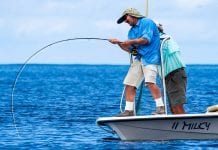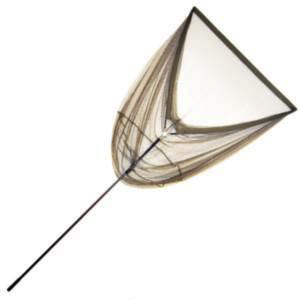 How many times have we walked into our local well stocked fishing tackle shop and seen before us a huge array of fishing tackle designed to meet every angler’s needs and then become lost in the decision – “What is the correct tackle for me?”
How many times have we walked into our local well stocked fishing tackle shop and seen before us a huge array of fishing tackle designed to meet every angler’s needs and then become lost in the decision – “What is the correct tackle for me?”
Preparation is the key to ensure you get the right kit for the job without over-spending on misguided purchases. The best place to start is to select a venue or two and understand the lake’s features.
How big is the lake? How big are the carp you are hoping to catch? Is the lake weedy or snaggy? All of these key points have a dramatic impact on the type of equipment you will need. This will stop you first buying tackle and then finding it’s not right for you and having to sell it again in order to buy the correct stuff.
Without a doubt, there is a lot of very good, low priced tackle available on the market and, as in most sports, it is very easy to spend thousands on equipment. You have to beware. There is a lot of tackle that catches unwary anglers rather than catching fish. So where do we start when we have decided that carp fishing is going to be our hobby from now on?
 The basic carp fishing tackle requirements are as follows.
The basic carp fishing tackle requirements are as follows.
Landing net, unhooking mat and fish care products.
Carp rod.
Reels, (free spool or big pits) and line.
Rod rests and alarms.
Seat and shelters.
Products: Landing nets, unhooking mats and fish care products.
Landing nets: The larger the better so you should really look for a 42” or larger. A net with a deep and soft mesh is required. Make sure the net has a fine mesh as this will prevent the carp’s fins from catching in the mesh whilst it is being landed. The landing net should also have removable arms which will make carrying the carp to the unhooking mat much easier and safer. Make sure the landing net has a strong pole and the pole is at least 1.82m long.
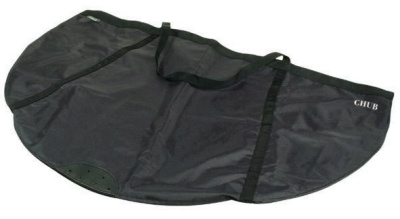 Mats: A large, deeply padded unhooking mat is essential to protect the fish. Carp are naturally buoyant in water and do not feel their own weight; once out of water they feel every ounce, so a soft unhooking mat helps protect their body from damage, as and when they begin to struggle. Mats are available in a flat or a cradle style format with a poly ball or soft foam internal filling. The cradle style mat has the slight advantage over the flat mat as it has a high wall construction which will help prevent the carp from sliding off the mat.
Mats: A large, deeply padded unhooking mat is essential to protect the fish. Carp are naturally buoyant in water and do not feel their own weight; once out of water they feel every ounce, so a soft unhooking mat helps protect their body from damage, as and when they begin to struggle. Mats are available in a flat or a cradle style format with a poly ball or soft foam internal filling. The cradle style mat has the slight advantage over the flat mat as it has a high wall construction which will help prevent the carp from sliding off the mat.
A strong pair of forceps will be needed to remove the hook from the carp’s mouth. It is always a good idea to have these attached to the mat. Always remove the sharp hook from the carp with the forceps, as this prevents the carp from moving the hook to your fingers whilst you are trying to unhook it.
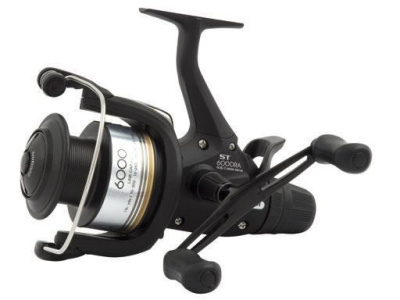 Carp care kits are available from a number of companies and the Korda Carp care kits designed by Thinking Anglers are the best available at the moment. You can also buy products such as Kryston Klinik carp care, which is also a good antiseptic/barrier. The Korda kit includes mouth and body liquid treatments with a few swabs included to assist in applying the treatments accurately onto the wounds.
Carp care kits are available from a number of companies and the Korda Carp care kits designed by Thinking Anglers are the best available at the moment. You can also buy products such as Kryston Klinik carp care, which is also a good antiseptic/barrier. The Korda kit includes mouth and body liquid treatments with a few swabs included to assist in applying the treatments accurately onto the wounds.
Weigh slings are available in all shapes and sizes. Choose a sling that is soft and one that will support the fish well whilst it is being weighed. A sling with front and rear access zips also makes releasing the carp back into the water a lot
easier.
Scales are available in both digital from manufacturers like Chub and Ruben Heaton and mechanical scales by Avon and Ruben Heaton. Take time and choose a good quality set and keep them safe clean and dry to ensure they are as accurate as possible. When weighting your catch take a little time to wet the sling and zero your scales so they are ready for use when you need them.
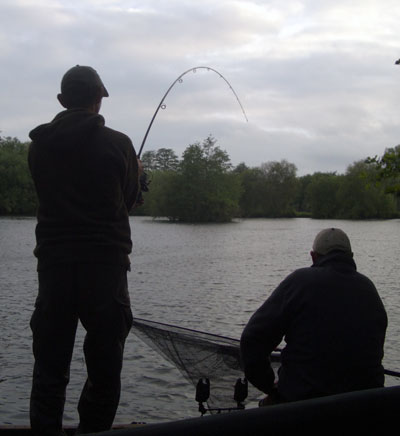 Rods
Rods
Test curve: The test curve is the weight required to bring the tip to a 90 degree angle to the butt while the butt is held horizontally. This measurement provides a guide to the stiffness of one rod compared to another. The test curve on its own is not an indicator of casting capability however. Of more influence on a rod’s casting potential, is the action of the rod. For example a fast-taper 2.751b test curve rod will have greater casting capability than a through-action 3.51b test curve rod, but the through-action rod will have other benefits over the faster-action rod.
Rod Actions: For simplicity, only three types of rod action tend to be referred to in the press: 1) Through-action 2) Semi-fast 3) Fast taper. However, there is a whole spectrum of actions between these, and there are points in the spectrum where the definition of the action is a matter of opinion. For example some people may describe the same action as either a semi-fast or a through-action. Also semi-fast and fast-taper actions become confused. The result is that the action of a rod described in the angling press is sometimes misleading.
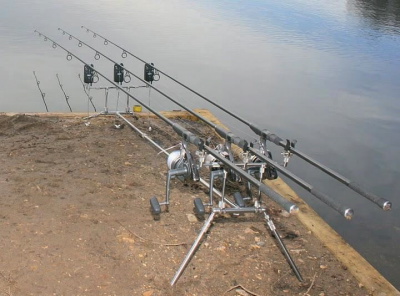
Through-action rods are a dream for playing fish as the rod can be allowed to play the fish without the angler having to continually adjust the clutch or back-wind. They also minimize the chance of hook pulls, allow the use of lighter breaking strain lines and hooklinks and are the best rods for accurately casting at shorter range. They also perform well when using light leads. Through-action rods are not a good choice if distance casting could be necessary and only the higher test curve models are suited to method fishing and PVA bag work.
Semi-fast-action rods are also referred to as “medium action”. These have a progressive action and are normally a compound-taper or parabolic by nature. Most general carp rods are built to have this action. These rods will cast medium-sized PVA bags and method balls (dependent upon their test curve) accurately with ease and they generally play fish well. They do not require specialist casting techniques to achieve good casts. Please note semi-fast rods do not cope well with extreme-range, continual long-range or large PVA bags or heavy method feeder work. A semi-fast action is therefore an all-rounder’s action. There are many variations on this theme so it is always well worth asking advice from people who use the rods. The internet forums and local tackle shops are good sources because seeking knowledgeable advice is important.
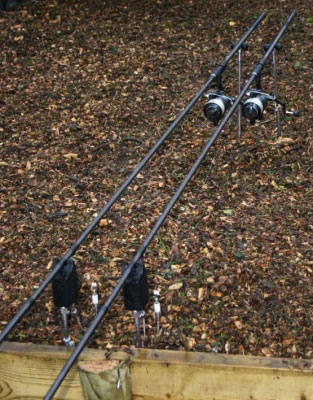 Fast-action rods are best for extreme-range or long-range casting, but require a good casting technique to realise their full potential. They are at their best when casting heavier weights such as larger PVA bags or method balls. The action of these rods is often been called ‘wooden’ or ‘like fishing with a broom stick’ and therefore is the least enjoyable action with which to play fish. The stiff, unforgiving casting action creates a greater chance of hook pulls or hooklink breakage and relies upon the stretch in the main line whilst at range and good clutch control to minimise these problems. Fast-action rods are also difficult to cast accurately at shorter range (under 70 yards) because a little extra effort on the cast results in a lot more distance, generally making it difficult to place a baited rig under an overhanging tree line for example.
Fast-action rods are best for extreme-range or long-range casting, but require a good casting technique to realise their full potential. They are at their best when casting heavier weights such as larger PVA bags or method balls. The action of these rods is often been called ‘wooden’ or ‘like fishing with a broom stick’ and therefore is the least enjoyable action with which to play fish. The stiff, unforgiving casting action creates a greater chance of hook pulls or hooklink breakage and relies upon the stretch in the main line whilst at range and good clutch control to minimise these problems. Fast-action rods are also difficult to cast accurately at shorter range (under 70 yards) because a little extra effort on the cast results in a lot more distance, generally making it difficult to place a baited rig under an overhanging tree line for example.
Character.
The action and test curve both affect the ‘character’ of a rod, but there are other factors that influence the feel, balance and recovery rate and therefore change the character. The type of carbon cloth used, the position, number and type of rod guides, the position of the reel seat, the type of handle and other factors can all have an effect.
50mm butt rings – pros & cons: 50mm butt rings have become more popular in recent years because they reduce the chance of the line grabbing the butt ring during casting – a problem that is more evident when using reels with large diameter spools. However the benefit of the 50mm ring needs to be weighed against other considerations; they may fit awkwardly in your present luggage. Also because of their size, 50mm rings are more vulnerable, so need care to avoid damage.
A compromise is always needed with fishing tackle and you will always get a lot more fun from the fish you hook and catch if your tackle is well balanced.
To give you an rough idea of what rods should be able to achieve:
TC Casting Weight Water Type
2.5lb | 2.5oz | Small lakes, little or no snags
2.75lb | 3 oz | Small-medium lakes, slightly snaggy
3.00lb | 3.5 oz | Medium lakes snaggy
3.25lb | 4 oz | Medium large lakes, solid PVA bags or method feeders, snaggy
3.5lb | 4.5 oz | Large lakes, snaggy, solid PVA bags or method feeders
Ian Gemson www.smartcarping.com
To be continued.
——-











